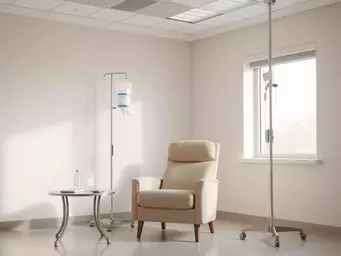Targeted Therapy vs. Traditional Chemotherapy
By Dr. Elise Carter / Nov 21
Have you ever felt lost navigating your chemotherapy treatment schedule? Understanding the structure and timing of your chemotherapy can empower you to take charge of your health. Here’s a breakdown of key insights that can guide you through this challenging journey.
Understanding the structure of chemotherapy treatment, including cycles, frequency, and overall duration, is key for patients and caregivers.
A cycle typically includes drug administration followed by a recovery period.
Frequency varies significantly based on specific regimen and patient needs.
Total length of chemotherapy treatment varies significantly.
Chemotherapy can have different goals depending on when it's administered.
When it comes to chemotherapy, understanding the structure of your treatment schedule can feel daunting. However, having a grasp of what chemotherapy is and why a well-organized schedule matters can significantly ease your journey. Let’s dive into the foundational elements to help you feel more informed and empowered.
Chemotherapy is a type of cancer treatment that uses powerful drugs to kill or slow the growth of cancer cells. It’s important to note that chemotherapy can target not just cancer but also rapidly dividing healthy cells, which can lead to side effects. My experience as an oncologist has shown me that understanding the basics of chemotherapy helps patients feel more in control of their treatment process.
A structured treatment schedule is crucial for maximizing the effectiveness of chemotherapy. It ensures that you receive the right doses at the right times, allowing your body to recover between treatments. Here are some key reasons why this structure is vital:
By adhering to a clear schedule, you work closely with your healthcare team to navigate your treatment effectively. This collaborative approach fosters a sense of partnership, making your cancer journey a bit more manageable.
Understanding the cycles and courses of chemotherapy is essential for planning and anticipating your treatment journey. These terms describe how chemotherapy is administered over time, which can vary based on individual needs. Let's explore what these cycles look like.
Typically, a chemotherapy cycle can last anywhere from a few days to several weeks, depending on the specific regimen prescribed for you. Generally, a cycle includes the administration of drugs followed by a recovery period. This cycle structure is designed not only to treat cancer effectively but also to help your body recuperate, as detailed by Cancer Research UK.
The frequency of your chemotherapy cycles can vary significantly. Most patients will experience one of the following schedules:
Understanding your specific cycle frequency helps you prepare mentally and emotionally for what’s ahead!
Another important distinction in chemotherapy treatment is between neoadjuvant and adjuvant therapy. Neoadjuvant therapy is given before surgery to shrink tumors, while adjuvant therapy follows surgery to eliminate any remaining cancer cells. Understanding these objectives helps clarify your treatment plan and keeps you actively engaged in your care. For more detailed information on these distinctions, refer to resources like this article on adjuvant chemotherapy.
The length of a chemotherapy course can vary significantly based on the type of cancer and the specific treatment plan. Generally, courses may last from a few months to over a year. Knowing how long you will be undergoing treatment can help you arrange your life accordingly and better prepare for the journey ahead.
Several factors can influence the overall duration of your chemotherapy treatment:
By discussing these factors with your oncologist, you can gain a clearer picture of what to expect!
Your healthcare team will create a treatment protocol tailored to your specific needs, which plays a key role in determining the duration of your chemotherapy course. Protocols consider your cancer type, response to treatment, and any side effects you may experience. This individualized approach is designed to optimize your care and help you achieve the best possible outcomes.
Did you know? Keeping a detailed log of your chemotherapy schedule and side effects can significantly enhance your communication with your healthcare team. This practice not only helps you track your treatment progress but also allows you to share valuable insights with your oncologist, leading to more personalized care.
As we wrap up our discussion on chemotherapy schedules, it’s essential to emphasize the importance of maintaining an open line of communication with your oncologist. Understanding your treatment plan is crucial for effective management and care. Have you ever felt unsure about your next steps or what to expect? You're not alone, and addressing these concerns openly can lead to better outcomes.
Here are some key points to remember when discussing your chemotherapy schedule with your healthcare team:
Taking these steps can help you feel more in control of your chemotherapy journey. Remember, your oncologist is there to support you, and their insights are invaluable in navigating your schedule.
Understanding your chemotherapy schedule is not just about knowing when to show up for treatment; it's about empowering yourself to make informed decisions about your health. At Types of Chemotherapy, we believe that knowledge is a powerful tool. By familiarizing yourself with your treatment plan, you can enhance your ability to cope with side effects and manage your daily life effectively.
Here are some strategies to help you take charge:
By actively participating in your care, you can contribute to better health outcomes. Don’t hesitate to reach out for resources that can help you along the way!
To further support your journey, Types of Chemotherapy offers a variety of educational resources tailored for patients and caregivers. We focus on making complex medical information accessible and understandable. By utilizing these materials, you can enhance your health literacy and feel more confident in discussions with your healthcare team.
Some examples of resources available include:
Remember, the more informed you are, the better equipped you'll be to navigate your chemotherapy journey!
As you progress through your treatment, it's crucial to know where to find additional support and information. From understanding your chemotherapy schedule to connecting with others, various resources can assist you. Our mission at Types of Chemotherapy is to provide a supportive network and reliable information to empower you during this challenging time.
Consider these options for further support:
Exploring these resources can help you feel less isolated and more connected to the larger community.
Finding the right community support can make a significant difference in your treatment experience. Whether online or in-person, connecting with others who understand your journey can provide comfort and practical advice. Have you thought about reaching out to local organizations or online patient groups?
Here are a few ways to locate community support:
Don’t hesitate to lean on these resources! They can be a vital part of your support system.
In closing, I want to emphasize the importance of staying informed and empowered throughout your treatment. It’s natural to feel overwhelmed, but remember that you are not alone in this journey. By actively participating in your care and seeking out the information you need, you can navigate your chemotherapy schedule more effectively.
Let's not forget the emotional aspect of cancer treatment. Engage with your support network, whether that's friends, family, or fellow patients. Have you found solace in sharing your experiences with others? If not, I encourage you to explore these connections!
Stay strong and proactive, and remember that at Types of Chemotherapy, we are here to support you every step of the way!
Here is a quick recap of the important points discussed in the article:



 Targeted Therapy vs. Traditional Chemotherapy
Have you considered how understanding cancer treatments can empower your journey? Knowledge not only
Targeted Therapy vs. Traditional Chemotherapy
Have you considered how understanding cancer treatments can empower your journey? Knowledge not only
 Nutrition Strategies for Chemotherapy Patients
Nutrition plays a critical role in supporting your body during chemotherapy. By making informed diet
Nutrition Strategies for Chemotherapy Patients
Nutrition plays a critical role in supporting your body during chemotherapy. By making informed diet
 Preparing for Your First Chemotherapy
Have you ever felt overwhelmed at the thought of a major medical treatment? The uncertainty and anxi
Preparing for Your First Chemotherapy
Have you ever felt overwhelmed at the thought of a major medical treatment? The uncertainty and anxi